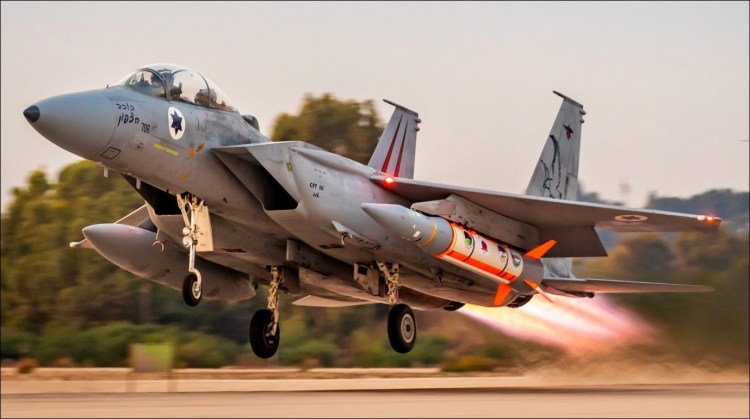Introduction
This is Part 2 of a two-part series on the October 25/26 Israeli air strike on Iran. The first part is here NSA Leak Causes Feeble Israeli Attack on Iran and discusses how an NSA leak may have affected the viability of the strike. This article covers the weapons used and the results of the attack.
The Evolution of Strike ALBMs
During the 1991 Gulf War, Saddam Hussein of Iraq launched SCUD ballistic missiles at Tel Aviv. These were “Extended-Range” Scuds. To reach Israel, their payload was halved and fuel capacity increased. Early versions of the Patriot ABM system were deployed to protect Israel with limited to no success. The modifications made to the SCUDs upset their trim and caused them to tumble through the terminal phase. The tumbling upset the Patriots’ guidance.
Following the Gulf War, Israel resolved to collaborate with the US to build its own air defense missile system. The result was the layered Iron Dome, David’s Sling, and Arrow 3 complex. Development of the complex, however, required testing.
Israel developed a series of test missiles. Figure 2 shows three test target missiles developed for the program.

Figure 2 shows the three versions of the Sparrow target missile system. The Black Sparrow is a short-range missile designed to emulate late-model extended-range Scuds. Both the Black Sparrow and Blue Sparrow were used as test targets for the Arrow 2 ABM. Both of these missiles can be launched from modified F-16i or F-15i strike aircraft.
The Silver Sparrow is meant to emulate Iran’s Shahab-3 IRBMs with a range of 1,200 miles. Air-launched, it flies on a ballistic trajectory, climbing to a high altitude, reaching an apogee, and plunging earthward toward its target. This emulates the behavior of a target the Arrow 3 ABM must intercept. The Silver Sparrow, because of its large size, must be launched from a C-130 cargo plane.
Notice from Figure 2 that the Black Sparrow is a single-stage missile. The Blue Sparrow and Silver Sparrow are staged missiles with boosters. In recent attacks on Iran, Blue Sparrow boosters have been found in Iraq where they were jettisoned.
Weaponizing the Target Missiles
Israel has always been vexed by the distance between itself and its arch-enemy, Iran. Separated by twelve hundred miles and several countries, Iran could not be attacked except by long-range ballistic missiles, submarine-launched cruise missiles, or aircraft that required mid-air refueling.
One solution was the development of air-launched ballistic missiles, or ALBMs. Israel seized upon its test target missiles, which were already air-launched. Its first effort was ROCKS, a development of the Black Sparrow missile, with a range of 300 to 500 miles depending on payload and configuration. The Israeli manufacturer, Rafael, offered ROCKS up for export. It’s a weaponized Black Sparrow. This video shows the ROCKS ALBM in action.
ROCKS is equipped with GPS-independent guidance, a means of defeating GPS-jamming. The Russians, in particular, have proven themselves proficient at GPS-jamming. They have reduced the effectiveness of the Excalibur GPS-guided artillery shell to just 5% and are regularly defeating ATACMs and Storm Shadows. ROCKS sports an inertial navigation system (INS) that works with its GPS to get the missile close to its target even if the GPS is jammed. It then switches to a infrared optical guidance with pattern matching for the final approach.
The Blue Sparrow was also easy to weaponize. Following a large Iranian missile strike on Israeli targets on April 13, Israel launched a limited air strike on Iranian targets. The attack, on April 17, left analysts puzzled until military debris was found on the ground in Iraq. The “debris” turned out to be the spent rocket booster of a Blue Sparrow. This was highly indicative of a standoff attack with Blue Sparrow missiles equipped with live warheads.
This video discusses the Blue Sparrow missile.
Israeli aircraft launched the Blue Sparrows over Iraq, then turned around and flew home. The missiles dropped their boosters and the warheads continued on to their targets.

On October 17, a top-secret document from the National Security Agency (NSA) and the National Geospatial-Intelligence Agency was published on Telegram by an Iran-linked channel. An image of the document appears in this post on Twitter-X:
The document outlined American surveillance of Israeli preparations to attack Iran. It detailed the weapons systems involved and the numbers deployed. The documents did not explicitly disclose the timing of the attack or its intended targets, but the latter could be inferred from the selection of weapons.
For a discussion of the October 25/26 Israeli attack on Iran, the reader is referred to the following SOFREP article: NSA Leak Causes Feeble Israeli Attack on Iran.
Notice that the document specifically mentions 40 ROCKS missiles, the evolution of which we have discussed above. The intriguing point is that it further mentions the deployment of 16 “Golden Horizon” missiles, and special dollies used to handle them.
It is believed that the Golden Horizon is a further development of the Silver Sparrow missile. Recall that the Silver Sparrow must be launched from a C-130. The Golden Horizon can be launched from an F-15i. The target missile and ALBM are shown in Figure 4.

The Golden Horizon looks like a weaponized Silver Sparrow, adapted for launch by an F-15i. The weapon has a comparable booster but a much larger warhead. The leak suggested that the Israelis planned to replicate their attack of April 18 with 40 ROCKS to take out radar sites and 16 Golden Sparrows for use in a decapitation strike.
Golden Sparrows could be equipped with a variety of warheads, including nuclear, canister, high-explosive, and bunker-busting. Bunker-busting warheads can even be cement. The kinetic energy of a cement-filled ballistic missile warhead arriving at several miles per second is immense.
All of these missiles are ballistic. That is, they are only capable of limited maneuvering in their terminal phase. ROCKS and Golden Horizon have attitude adjusters that provide limited maneuvering but we are not able to compare this capability to the more advanced models of Russia’s Iskander.
We have no specific information on the Golden Horizon’s guidance, but as a first approximation, it is probably similar to ROCKS. That is, GPS/INS with infrared optical pattern matching in the terminal phase. The missile is guided to the vicinity of the target by GPS/INS. At that point, infrared guidance kicks in and makes finer attitude corrections.
The Mission and the Results
For a more detailed treatment of the strike, see the article referenced above. The important thing to note is that the mission proceeded in two phases: 1) Phase I – Suppression of Enemy Air Defense (SEAD) and 2) Phase II – long range strikes. The SEAD was to be accomplished by 40 ROCKS targeting Iranian radars in Syria, Iraq and Iran. The long range strikes were to be accomplished by 16 Golden Horizon missiles.
The mission failed at Phase I. As was pointed out in the earlier article, Russian radars and AWACS were not targeted. Russia and Iran share information. Russian radars pick up every airplane taking off from Israel and pass target cueing data to Russian-manned S-400 air defense in Iran. Israel did not target Russian sites and personnel. Furthermore, after the NSA intelligence leak of October 17, Iran would have moved its air defense radars.
While Israel may have destroyed a handful of Iranian radar sites (they probably targeted 20 with a total of 40 ROCKS) they did not succeed in SEAD. Nevertheless, they launched their 16 Golden Sparrows at military targets. The Israeli aircraft then turned for home.
Iranian S-300s and Russian S-400s put up an effective air defense. The ROCKS and Golden Horizons were not getting through. As discussed in the previous article, there are no videos of Israeli missile strikes on the ground. There are videos of air defense intercepting incoming threats as in this video: First wave, Tehran – AD engaging threats. Incoming threats travel from right to left in the frame.
Israel claims to have completely destroyed Iran’s air defense. This cannot be true. They may have struck a few S-300 radars, but not all. We know that the four Iranian military casualties were lost at an Iranian radar site. The Israelis did not strike Russian S400 systems and did nothing about Russian radars.
Further, Israel claimed to have struck a solid fuel manufacturing facility in Khojir, twelve miles from Tehran. They boasted that the destruction of the Khojir facility would set Iran’s missile production back two and a half years.
The latter claim cannot be true. Figure 5 shows that Israeli missiles destroyed or damaged only two buildings that house blenders for mixing solid fuel for rockets. The damaged buildings are circled and highlighted by arrows.

The thing to notice is the structure of the facility. All the blender buildings are set in excavated pits surrounded by high earthen berms. This is so an explosion in one building does not cause explosions in other buildings. The facility is broken up into at least fifteen buildings we can count, each of them isolated from the others and protected by berms.
We know that Iran has built underground missile factories and “missile cities.” It is likely that additional blending facilities are underground. However, looking at the Khojir layout, it is apparent that to destroy all the buildings, at least fifteen Golden Horizons would have been required with perfect accuracy. The Israelis went with sixteen and spread the loadout among other military targets. Most of the missiles were intercepted. There was no way they were going to completely destroy Iran’s capability, even if all the missiles got through. The destroyed blenders are made in China, who will have no reluctance replacing them.

Conclusions
From the NSA leak on October 17 to the aftermath of the strike on October 26, the story of this operation is what is colloquially referred to as a cluster. However, careful study allows us to draw some useful conclusions. As more information comes to light, we will have opportunities to further evaluate the operation. For the moment, here are main points.
Israel’s ALBM technology is excellent. ROCKS is good. It is roughly comparable to Russia’s Iskander, but less flexible. The Golden Horizon, which Israel had kept a closely-held secret, is very good. Israel’s ALBMs are terrific weapons if they can get through.
However excellent Israel’s missile technology, Iran’s (and Russia’s) air defense was superb. They stopped most of Israel’s incoming missiles.
Net-net, this state of affairs is a concern for us and Israel. Israel’s air defense can be penetrated by Iranian missile swarms. The October 1st attack proved that. On the other hand, Israel’s missiles, however excellent, cannot effectively penetrate Iran’s air defense.
This writer believes Iran should be treated as a de facto nuclear-armed state. Combine that with effective air defense, and Israel can’t defeat it, even with our help. Until we can defeat Iran’s air defense, Israel must adjust its strategy. It has to concentrate on defeating Iranian proxies in conventional combat.
About the Author

You may contact Cameron at: [email protected]
Cameron Curtis has spent thirty years in the financial markets as a trader and risk manager. He was on the trade floor when Saddam’s tanks rolled into Kuwait, when the air wars opened over Baghdad and Belgrade, and when the financial crisis swallowed the world. He’s studied military affairs and warfare all his adult life. His popular Breed series of military adventure thrillers are admired for combining deep expertise with propulsive action. The premises are realistic, the stories adrenaline-fuelled and emotionally engaging. Check out the books here: Cameron Curtis’s Amazon Page

**Listen up, SOFREP! It’s damn near holiday season and I can’t think of better stocking stuffers than any of the Breed series of books by Cameron Curtis. Why not pick up a copy of BLOWBACK today? I guarantee you’ll be going back for the rest of them before long. –GDM



